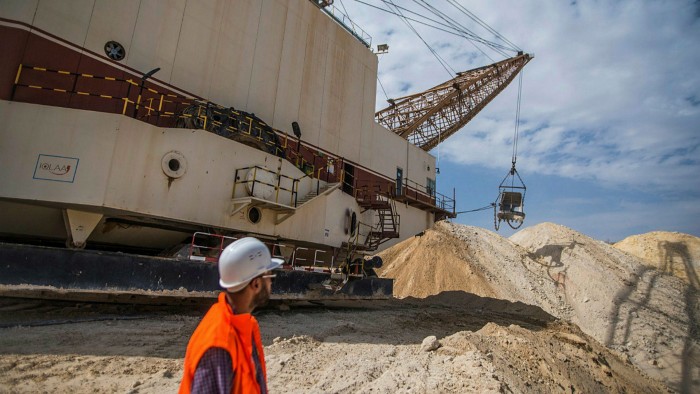Efforts to halt soil depletion find fertile ground in Africa

Roula Khalaf, Editor of the FT, selects her favourite stories in this weekly newsletter.
Ivory Coast is the world’s top exporter of cocoa, the main ingredient in chocolate, and a crop that has for decades formed the mainstay of the west African country’s economy, bringing in billions of dollars.
Planted by smallholders on forest land, cocoa has been a success story for Ivory Coast during 50 years of almost uninterrupted expansion. But in the first decade of this century, production of the crop began to falter and soil depletion was identified as the main cause of declining yields.
“Cocoa farms were set up in the most fertile forest lands in the 1960s but for decades cocoa beans exports have also meant [in reality] exporting nutrients from the soil. Farmers did not use fertiliser so soils were depleted,” says Jonas Mva Mva, cocoa programme director at IDH, the sustainable trade initiative set up by the Dutch government.
To address the decline, the organisation spearheaded a programme in 2012 aimed at facilitating farmers’ access to fertiliser and educating them in its use through a partnership between fertiliser companies, traders, government and the cocoa industry.
OCP, the Moroccan state-owned company and the world’s biggest phosphates exporter, was a primary sponsor of the scheme, providing fertiliser specifically tailored for cocoa. Another partner was Yara, the Norwegian fertiliser company. The programme resulted in increased productivity from an average of 300-450kg per hectare to 750-800kg for farmers, according to Mr Mva Mva.
Fertiliser use in Africa is the lowest in the world with the continent accounting for 3 per cent of global consumption compared with 57 per cent in Asia.
But soil depletion in many places remains a significant problem, affecting yields and threatening both domestic food security and revenues derived from export crops.
In a 2016 report, the UN Food and Agriculture Organization (FAO) said 40 per cent of soils in Africa were suffering from some form of degradation, including erosion and loss of nutrients.
African leaders had pledged at a summit in 2006 to increase average fertiliser use to 50kg per hectare by 2015 up from 7kg. The target was missed and today consumption remains low at 15kg compared with a global average of 134kg.
Seizing the opportunity to drive the use of phosphate-based fertiliser on the continent, OCP has been expanding in sub-Saharan markets to achieve a dominant position in recent years, accounting for 61 per cent of all sales of this type of fertiliser in Africa.
With customised products adapted to local soils and specific crops, and supported by outreach to educate farmers, the company has increased sales in Africa nearly tenfold from 245,000 tonnes in 2010 to 2.1m tonnes in 2020, according to figures supplied by OCP.
Fayçal Benameur, OCP’s senior vice-president for east Africa, says: “In other [regions] you are fighting the competition for market share, but in Africa you are creating demand.”
Central to OCP’s strategy, he says, has been the provision of customised formulas. This requires research and analysis to be able to understand the needs of different soils. In some countries, the company sends big trucks with mobile labs to visit remote areas where they test local soils and meet farmers to offer training and advice on the specific fertiliser blends needed in their fields.
“We are meeting the farmers every single day, not only for soil testing but in each village we provide specific training for the crops they are growing there,” says Mr Benameur.
In Ethiopia, which accounts for almost half of OCP’s sales on the continent, Mr Benameur says the company has helped increase maize yields by 50 per cent. “Remember Ethiopia, which was once known for famine,” he says. “It now exports maize to Kenya.”
The country is now developing its sugar industry, he adds, with the aim of moving from being a net importer to joining the top 10 sugar exporters in the world within two years. OCP is supporting its programme for sugar cane cultivation. There are also plans for a joint venture with Ethiopia to build a fertiliser factory in the country.
Addressing soil deficiencies and improving the productivity of African lands is seen as critical both by governments and experts given the continent’s expanding population, which is forecast to rise by almost 1bn by 2050 to reach 2.2bn people. Already, food production is failing to keep pace with such rapid population growth. Despite having 60 per cent of the world’s uncultivated arable land, Africa’s food and agricultural import bill averages $72bn a year, according to the FAO.
Agriculture is also vital for economic growth and political stability, accounting for 20 per cent of the continent’s gross domestic product and 60 per cent of its labour force.
Fertiliser alone, though, will not solve the problem of poor soils, says Ronald Vargas, head of the Global Soil Partnership of the FAO.
The answer, he argues, lies in moving towards a sustainable soil management regime involving measures to protect soil from erosion and other threats, as well as preserving the soil’s ability to retain water.
This can include maintaining vegetation cover, minimising tillage and avoiding monocultures through crop rotation. “Fertiliser will help, but by itself it is a short-term solution,” Mr Vargas says.

Comments